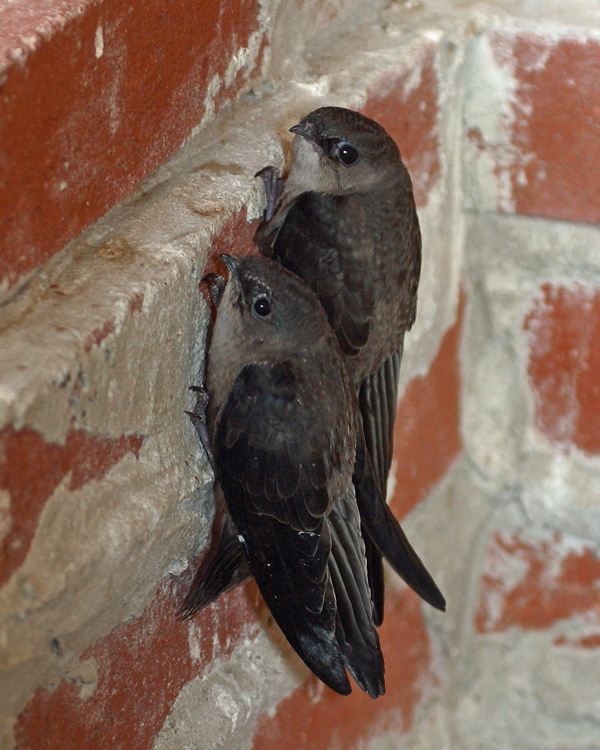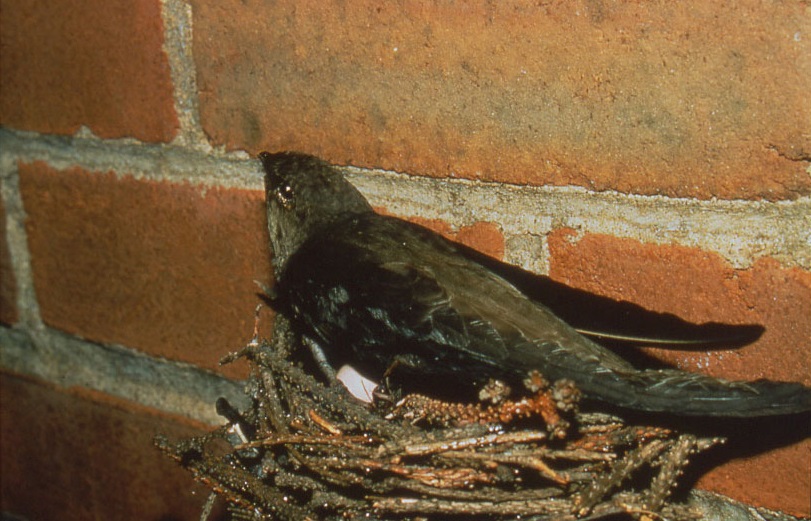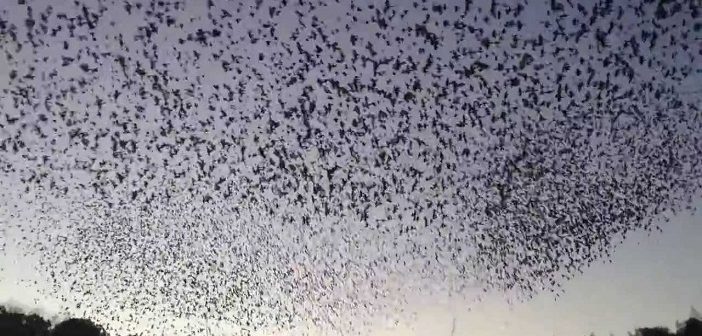The article below was paid for by a portion of a generous micro-grant provided through the 2nd annual Soup Ste. Marie event. Thank you!
Sault Ste. Marie, Ontario continues to have the largest roost population of chimney swifts in Canada. Between 2,000 – 2,500 chimney swifts frequent the historic downtown region, living within the Canada Post Office’s chimney, from mid- to late May until September before beginning their migratory path to South America. However, being a threatened species, the chimney swifts are at risk of extinction if current situations are not changed and awareness of the species continues to be low.
Today, chimney swifts can be found in Canada from Saskatchewan to Nova Scotia, with the majority of birds being found within the provinces of Ontario and Quebec. There is suspected to be 11,820 chimney swifts in Canada, though that number continues to drop annually. With the largest cohort of chimney swifts living in Northern Ontario at the hub of the Great Lakes, a team of biologists and naturalists have come together, under the name Algoma Swift Watch, to work to sustain the current population but also to figure out why these swifts call Sault Ste. Marie their home.
(Below, a video taken of Chimney Swifts pouring into the Sault Ste. Marie Courthouse)
“We don’t know why there’s such a high population,” begins Brandan Norman, the current Chimney Swift Monitoring and Outreach Intern with Algoma Swift Watch, a position which is funded by the Northern Ontario Heritage Fund Corporation through a grant from the Ministry of Natural Resources to the Sault Naturalists. “It seems that aerial insectivores are doing really well in this area.” Local naturalist, John Raltson, has been monitoring the roost since 2006, when he discovered it after learning about ‘A Swift Night Out’, a continent-wide effort to raise awareness for chimney swifts and their western North American relative, Vaux’s swift. Dr. Jennifer Foote, Dr. Jennie Pearce, and the Sault Naturalists began studying the swift roost in 2015. Preliminary work suggests the Sault Ste. Marie roosting population may be relative stable, while other roosts have seen fewer birds each year. “Between 1968 and 2005, population roosts have dropped by 95 percent. That’s been roughly the same case with all aerial insectivores across Canada.”
Chimney swifts are unique birds. While the swift looks like a swallow, the species is more closely related to a hummingbird. With very long wings and an aerodynamic body, chimney swifts are unable to perch like normal birds because their feet are too short. Rather than perching, they utilize their short feet and tail feathers to prop them up, creating a tripod-like mechanism. Their tail feathers, which contain prickly bristles, enables swifts to attach themselves vertically to various objects, most commonly, hollowed trees, caves and caverns, or chimneys. Their bristles and feet act as Velcro, sticking them in place to roost.
The idea of a using a chimney to roost isn’t new. In fact, historical documents report swifts using chimneys for a natural habitat as early as 1962 in New England.
Their method of communication is also unique and is most commonly known as chittering. “When they’re swirling around the roost, you hear them. They’re quite noisy birds.”
Swifts are brownish black in colour with a pale throat. Being aerial insectivores, they feed on insects and catch them in the air. They forage for food throughout the day and fly at high altitude. In fact, swifts fly at some of the highest altitude compared to other bird species, making them difficult to spot. They do, however, come down from high heights to get water, but most often frequent rivers where insect emergences are happening. Chimney swifts prefer to feed on more nutrient-filled insects, like beetles, but most often eat mosquitos. Despite weighing only 17 – 30 grams as an adult, which is the equivalent to the weight of three Canadian Loonies, a single adult chimney swift can eat 1,000 mosquitoes in a day. Although swifts have small beaks, they can open their beak wide, allowing them to simply fly into a cloud of insects and eat.
Even though chimney swifts feed on thousands of mosquitoes throughout their lives, there have been no reports in Canada of swifts contracting blood-borne diseases like Zika Virus, Avian Flu, or West Nile Virus. In America, there’s been one case of West Nile. “Chimney swifts are very safe birds. If you do ever have one fall down your chimney, you don’t have to worry about them carrying diseases. Even their feces aren’t known to cause illness or carry disease.”
 In courtship, chimney swifts form pairs. They hold their wings in a V-shape and glide by each other during pair formation. If the female is impressed, she chooses her mate. The pair secures a breeding site, which consists of only the male and female swift, different from the roosting chimney, where hundreds to thousands cohabitate. The pair then creates a nest on a vertical surface. The nest is similar to a barn swallow’s mud cup nest, but is instead constructed out of sticks and their own saliva, which acts like a bonding agent or glue. “Their glands swell during breeding season so they can accommodate this extra need.” Occasionally, the pair of swifts will have a helper, which according to Norman, is relatively rare in the animal kingdom. These helpers could be previous year’s chicks or a non-breeding bird that will help with feeding and the incubation process. The female swift will then lay between three to five white eggs in the nest. Incubation takes approximately 16 days, and then the chicks will stay in the nest for another 19 days, being fed by their parents before fledging.
In courtship, chimney swifts form pairs. They hold their wings in a V-shape and glide by each other during pair formation. If the female is impressed, she chooses her mate. The pair secures a breeding site, which consists of only the male and female swift, different from the roosting chimney, where hundreds to thousands cohabitate. The pair then creates a nest on a vertical surface. The nest is similar to a barn swallow’s mud cup nest, but is instead constructed out of sticks and their own saliva, which acts like a bonding agent or glue. “Their glands swell during breeding season so they can accommodate this extra need.” Occasionally, the pair of swifts will have a helper, which according to Norman, is relatively rare in the animal kingdom. These helpers could be previous year’s chicks or a non-breeding bird that will help with feeding and the incubation process. The female swift will then lay between three to five white eggs in the nest. Incubation takes approximately 16 days, and then the chicks will stay in the nest for another 19 days, being fed by their parents before fledging.
 According to Norman, the saliva, which is used to build the nest, also plays a crucial role in helping the chicks survive their initial days. “It’s important for the chicks to get some of the saliva. So when they’re being fed by their parents, they get some of that saliva and in turn, some of the microorganisms that their parents have accumulated. This helps the chicks digest food and helps them grow, as well. It’s kind of like mammals and milk – it’s the same idea.” Without having the natural saliva, it has also been difficult for homeowners to care for baby swifts who fall out of nests and down chimneys. Luckily, animal rehabilitators have generated a formula to recreate the saliva, saving fallen swifts.
According to Norman, the saliva, which is used to build the nest, also plays a crucial role in helping the chicks survive their initial days. “It’s important for the chicks to get some of the saliva. So when they’re being fed by their parents, they get some of that saliva and in turn, some of the microorganisms that their parents have accumulated. This helps the chicks digest food and helps them grow, as well. It’s kind of like mammals and milk – it’s the same idea.” Without having the natural saliva, it has also been difficult for homeowners to care for baby swifts who fall out of nests and down chimneys. Luckily, animal rehabilitators have generated a formula to recreate the saliva, saving fallen swifts.
Yet with everything scientists and researchers know about chimney swifts, there is still much unknown about the species. For example, when swifts migrate to South America, their knowledge of the bird stops. “In the winter, they’ll follow the Atlantic and Gulf Coast to northwestern South America, so countries like Peru, Colombia, Ecuador, parts of Brazil, and northern Chile. We have no idea what kind of habitat they use down there. We don’t know if they use hollowed trees, we don’t know if they’re using caves, or manmade structures. Basically, when chimney swifts make it to their winter climates, our knowledge stops. We know they’re somewhere there, but we don’t know where.”
But that’s where Algoma Swift Watch comes in.
While the group will not be able to monitor the migration of chimney swifts to warmer, tropical climates due to limitations in technologies and funding, they are working to better understand their habitats, and the factors that threaten chimney swifts, including predation, climate, and agricultural practices.
The group works out of the Essar Convergence Centre in Dr. Jennifer Foote’s lab at Algoma University, in close collaboration with Dr. Jennie Pearce and the Sault Naturalists. Algoma Swift Watch uses video cameras that have night vision capabilities to study and analyze the large roost in downtown Sault Ste. Marie. Currently, one camera is installed in the chimney of the Sault’s courthouse, where the roost was initially discovered, and unfortunately, disturbed in 2013 due to maintenance to the roof and chimney, which eventually saw the chimney capped. More cameras are planned to be installed at the post office. “So we’ll mount two cameras looking down the chimney and a third camera looking at the chimney.”
Also inside the chimney will be temperature probes to monitor the temperature fluctuation. It has been documented that a chimney can reach over 20 degrees Celsius higher than the outside temperature if a full roost of birds is living inside.
By placing cameras inside the chimney, Algoma Swift Watch will be able to record just how far down swifts use the chimney. The group is hoping to utilize this data and help homeowners and business owners make informed decisions when it comes time to cap their chimney. “If chimney swifts don’t use the chimney past four metres from the top, for instance, then you could cap lower than that and not harm them.” This research, according to Norman, is crucial. “There’s a current problem in protecting chimney swifts. Current policies protect migratory birds and species at risk, which is great. But when it comes to habitat, it protects natural habitat. Chimneys fall under artificial habitat. So while it is against the law to disturb them when they’re in [the chimney], when they’re not there, putting a cap on isn’t illegal. There’s really nothing you can do. But if we have this information, we can help people make more informed decisions that benefit both them and the swifts.”
Aside from looking at that actual roost, Algoma Swift Watch will examine predation by avian predators, such as herring gulls. “We’ll be looking at how many species prey on the swifts [and]how successful their predation is. We’re arguing that there’s the potential that avian predators that prey on swifts could drive their decline further. It’s very preliminary at this point.”
Lastly, the group will be examining the effects weather and climate change have on chimney swifts. It has been demonstrated that cold snaps or extended periods of rain will cause chimney swifts to die. If the temperature drops to around the zero Celsius mark, chimney swifts enter into a state of hibernation, which cannot be sustained for more than a few days. “In 1990, there was a roost in Quebec that had over 100 swifts die from sustained cold.” And with rainy weather, swifts begin to starve since there are fewer insects in the air. If they cannot feed regularly, they die. Other species of swifts, for example, in Britain and the Netherlands are frequently affected by rainy seasons.
Active weather, including hurricanes, also heavily influences swift populations during migration. “In 2005, there was a study that looked at Hurricane Wilma, and it was looking at Quebec roosts. There were 4,800 chimney swifts in Quebec, estimated. During the fall migration, Hurricane Wilma hit. There were a lot of reports of migratory birds dying from that. Chimney swifts were also found and when they went back to do their roost surveys in Quebec, the population dropped to 2,400, half of the population.”
Algoma University students are gaining valuable skills participating in the project. Dr. Foote’s lab includes a number of student volunteers, and full- and part-time undergraduate summer students who have had the opportunity to work on the project. “Last spring, three Algoma University biology students learned field observation skills by recording the roost using video equipment and taking detailed notes about the gathering swifts and their predators,” says Foote. “They also benefited from interacting with the community, including the Sault Naturalists, project partners, and interested local residents at the roost. My current students and I are all very excited to get involved in this project this spring when the birds return.”
Researching, however, isn’t enough. The group is eager to raise awareness of the prevalence of chimney swifts in the Sault. Norman will be visiting various schools in the area, and attending festivals to help inform the community. “We need to get people aware of them, understanding them, and building that sense of pride and ownership in Sault Ste. Marie residents concerning these birds. They’re unique and they’re threatened. It’s part of Sault Ste. Marie’s identity having this roost and nobody knows about it. And if we don’t know about it, they’ll become endangered, and worse, extinct. We cannot let that happen.” Migrating swifts rely on these large roosts during their trips between breeding and wintering grounds so they are an important habitat for stewardship.
Last year, one of the key outreach events Algoma Swift Watch held was a Swift Night. Essentially, citizens bring chairs or blankets and sit outside the post office and watch the birds at dusk when they’re just starting to enter the chimney. “As Jennie Pearce put it, instead of fireworks, we have chimney swifts,” he says with a laugh. The inaugural Swift Night saw over 100 people of all ages attend. Various Swift Nights have been scheduled throughout the month of May to encourage active population monitoring of the roost.
As awareness grows for chimney swifts and as more locals vocalize the presence of swifts in their chimneys, Algoma Swift Watch will need additional resources. The group is asking anyone interested in volunteering to contact Norman directly at algomaswiftwatch@gmail.com. Volunteers can assist with point counts, outreach, surveys, and more. Additionally, if you want to report a swift nest in your chimney or another roost in Northern Ontario, then please contact Norman.
For more information, please visit Algoma Swift Watch’s Facebook page.




1 Comment
Great article. I didn’t know anything about them before. Sure glad to have birds that eat insects around.